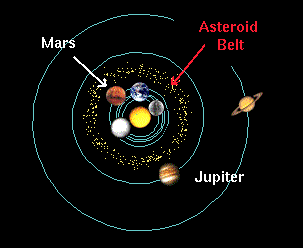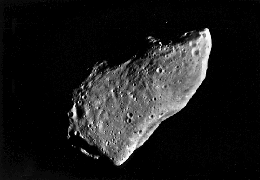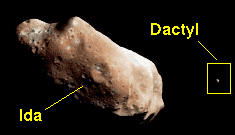General Properties of
Asteroids
 Asteroids represent material left over from the formation of the solar system.
Although is has been suggested that asteroids are the
remains of a planet that was destroyed in a massive collision, it is more
likely that they represent
material
that never coalesced into a planet. If the estimated total mass of all
asteroids was gathered into a
single object, the object would be less than
half the diameter
of the Moon
(Ref).
Asteroids represent material left over from the formation of the solar system.
Although is has been suggested that asteroids are the
remains of a planet that was destroyed in a massive collision, it is more
likely that they represent
material
that never coalesced into a planet. If the estimated total mass of all
asteroids was gathered into a
single object, the object would be less than
half the diameter
of the Moon
(Ref).
The Asteroid Belt
The highest concentration of asteroids is in a region lying between the orbits
of Mars and Jupiter called the
asteroid belt that is illustrated schematically in the adjacent figure.
Here is a more realistic
distribution of semimajor axes
for the minor planets. Some 7000 asteroids have been identified so far.
Most, but not all, have average orbital radii lying in the region of the
asteroid belt. It is likely that the origin of the asteroid belt lies in the
gravitational perturbation of Jupiter, which kept these planetisimals from
coelescing into larger bodies.
Kirkwood Gaps
Asteroid
orbit distributions
show evidence for
Kirkwood Gaps, which are certain orbital radii within the asteroid
belt for which there are few
asteroids. These gaps are associated with orbital radii that lead to orbital
periods that are ratios of
integer multiples of Jupiter's orbital radius.
They result from resonance interactions
with Jupiter that tend to eject asteroids from such orbits.
Galileo Flys by Gaspra
 The adjacent figure shows the asteroid Gaspra, which was investigated by the
Galileo spacecraft
(Ref).
Gaspra is irregular,
with dimensions
about 19 x 12 x 11 kilometers.
This image was taken 10
minutes before closest
approach on October 29, 1991, at a range of 5,300 kilometers.
The adjacent figure shows the asteroid Gaspra, which was investigated by the
Galileo spacecraft
(Ref).
Gaspra is irregular,
with dimensions
about 19 x 12 x 11 kilometers.
This image was taken 10
minutes before closest
approach on October 29, 1991, at a range of 5,300 kilometers.
The surface gravitational force is so weak on this small body that the
gravitational escape speed is only 10 meters per second---comparable to the
speed of a fast sprinter. In this gravitational field, a 200 pound man would
weigh only 0.1 pounds!
Gaspra has a high concentration of small craters compared to
larger ones relative to other small objects in the Solar System like the moons
of Mars (which may be captured asteroids).
This is consistent with the theory that Gaspra originated comparatively
recently
from the
collisional breakup of a larger body perhaps 10 times the present size of
Gaspra
(Ref).
The Asteroid Ida and its Moon Dactyl
 The Galileo spacecraft found a surprise when it flew by the asteroid Ida: Ida
has a
tiny moon, which has been named Dactyl!
The adjacent
color-enhanced picture shows both asteroid 243 Ida and Dactyl
at about 14 minutes before closest approach of Galileo on August 28, 1993,
at a range of
10,500
kilometers.
The Galileo spacecraft found a surprise when it flew by the asteroid Ida: Ida
has a
tiny moon, which has been named Dactyl!
The adjacent
color-enhanced picture shows both asteroid 243 Ida and Dactyl
at about 14 minutes before closest approach of Galileo on August 28, 1993,
at a range of
10,500
kilometers.
Ida (left)
is about 56
kilometers long and Dactyl (right) is about 1.5 kilometers
across in this view.
Dactyl is actually in the foreground,
about 80 kilometers
closer to the spacecraft than Ida is.
Dactyl is not identical in spectral properties to any area of Ida in view here,
though its overall
similarity in reflectance and general spectral type suggests that it is made of
basically the same
rock types
(Ref).
The Spin of Asteroid Toutatis
By making a series of observations,
it is possible to study the rotation of some asteroids. Most have
simple rotations around a fixed axis, with periods typically between one hour
and one day. For example, here is a movie (83 kB MPEG)
made by the Hubble Space Telescope
of the
asteroid Vesta
in rotation (Ref).
However,
the asteroid 4179
Toutatis (which crosses Earth's orbit)
has been found through radio telescope observations to have an
irregular shape and a complex tumbling rotation---both thought to
arise from a history of violent collisions.
Here is a short animation (47 kB MPEG)
of the spin of Toutatis.
It is believed that violent collisions are common for asteroids, and that many
asteroids have in their past experienced complex rotations like Toutatis as a
consequence of such collisions.
However, internal friction has caused them to dampen into simple rotation in
relatively brief
amounts of time; thus, most asteroids are observed to have simple rotations.
But Toutatis rotates so slowly that this dampening process
would take much
longer than the age of the Solar System. Thus, the rotation of
Toutatis may be
a relic of the collisional evolution of an asteroid
(Ref).
 Asteroids represent material left over from the formation of the solar system.
Although is has been suggested that asteroids are the
remains of a planet that was destroyed in a massive collision, it is more
likely that they represent
material
that never coalesced into a planet. If the estimated total mass of all
asteroids was gathered into a
single object, the object would be less than
half the diameter
of the Moon
(Ref).
Asteroids represent material left over from the formation of the solar system.
Although is has been suggested that asteroids are the
remains of a planet that was destroyed in a massive collision, it is more
likely that they represent
material
that never coalesced into a planet. If the estimated total mass of all
asteroids was gathered into a
single object, the object would be less than
half the diameter
of the Moon
(Ref).
 The adjacent figure shows the asteroid Gaspra, which was investigated by the
Galileo spacecraft
(Ref).
Gaspra is irregular,
with dimensions
about 19 x 12 x 11 kilometers.
This image was taken 10
minutes before closest
approach on October 29, 1991, at a range of 5,300 kilometers.
The adjacent figure shows the asteroid Gaspra, which was investigated by the
Galileo spacecraft
(Ref).
Gaspra is irregular,
with dimensions
about 19 x 12 x 11 kilometers.
This image was taken 10
minutes before closest
approach on October 29, 1991, at a range of 5,300 kilometers.
 The Galileo spacecraft found a surprise when it flew by the asteroid Ida: Ida
has a
tiny moon, which has been named Dactyl!
The adjacent
color-enhanced picture shows both asteroid 243 Ida and Dactyl
at about 14 minutes before closest approach of Galileo on August 28, 1993,
at a range of
10,500
kilometers.
The Galileo spacecraft found a surprise when it flew by the asteroid Ida: Ida
has a
tiny moon, which has been named Dactyl!
The adjacent
color-enhanced picture shows both asteroid 243 Ida and Dactyl
at about 14 minutes before closest approach of Galileo on August 28, 1993,
at a range of
10,500
kilometers.